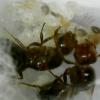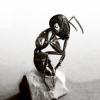I think it was Retroman who recommended the All Living Things Bearded Dragon food. It's basically an assortment of freeze dried insects which unfortunately my colonies didn't seem too interested in. Maybe it's too dry? Some of the Pogonomyrmex would drag pieces of it into the nest then back out the next day.
I decided to take a look at what else the reptile aisle had to offer and noticed a lot of the foods consist of the basic ant diet: proteins, sugar, insects, etc. so like a financially responsible adult, I decided to buy a random assortment of foods to try on the ants. I started off looking for ones with the highest protein concentration.
#1 First was the Zoomed Juvenile Crested Gecko Food:

Insects, fruit, vitamins, what's not to love? Comes in a dry powder form which makes feeding very easy (or messy if you had too much coffee). Tried it first on the Pheidole who usually eat anything, followed by the equally jittery Formica then the others. Initially, no one seemed extremely interested in it, they appeared to sniff around it and possibly eat it, but didn't go crazy for it. I thought maybe it's too dry so added a bit of water. With the water, some of the Pheidole and Formica began drinking the solution.
The next day, the Pheidole had completely cleaned the dish of it. Camponotus stacked it in a makeshift trash pile, and disappeared from some of the Pogonomyrmex but not others. So it appears to have mixed results. All in all, not amazing, not terrible. With the convenient powder form, it might be a good addition to any homemade foods.
#2 One of the first foods I tried in the hobby, but thought it belongs here anyway are Freeze Dried Bloodworms:

The smell is very pungent, so pungent that two rambunctious pugs managed to open the can and dump half it out and probably would've eaten it had I not caught them. The ants seem to notice the smell too, as almost all species will drag it into their nest. However, it tends to end up back outside the nest in a couple of days, seemingly untouched. My guess is it's too dry/hard for them to chop it up. I did try crushing it up once but didn't record the results well. It might be time for another trial.

Fine, if you ants think the others are too dry blah blah blah, what about this? Protein, fruits, and in gel form. Look at how dang happy that iguana on the label is. I gave each colony a cube last night and I might as well have gave them a cube of dirt. Actually, they probably would have been more excited with dirt. Pretty much ignored by everyone. The smell is a very strong citrus, which might be putting them off. The Formica did hug the cube for a bit, but I couldn't tell if it was eating it or just stretching its hamstrings. Will update tonight if there's any progress. If no update, assume this was a bust.

Ding ding ding! I think we have a winner, winner, cricket dinner. It's partially obvious why as this food is primarily dried flies (look a little large for fruit flies, though). It's not "just" flies though, there is a slight bit of moisture and it's very fragrant. The Pheidole instantly swarmed it and dragged it into their nest, a la frozen cricket style. Even the Formica dragged a few away. Hadn't yet seen if the Pogonomyrmex have eaten it but I can't imagine they wouldn't. I'm also not sure if the Camponotus have touched it, but they're my pickiest eaters.
Edited by Foogoo, August 5 2015 - 6:37 AM.






















